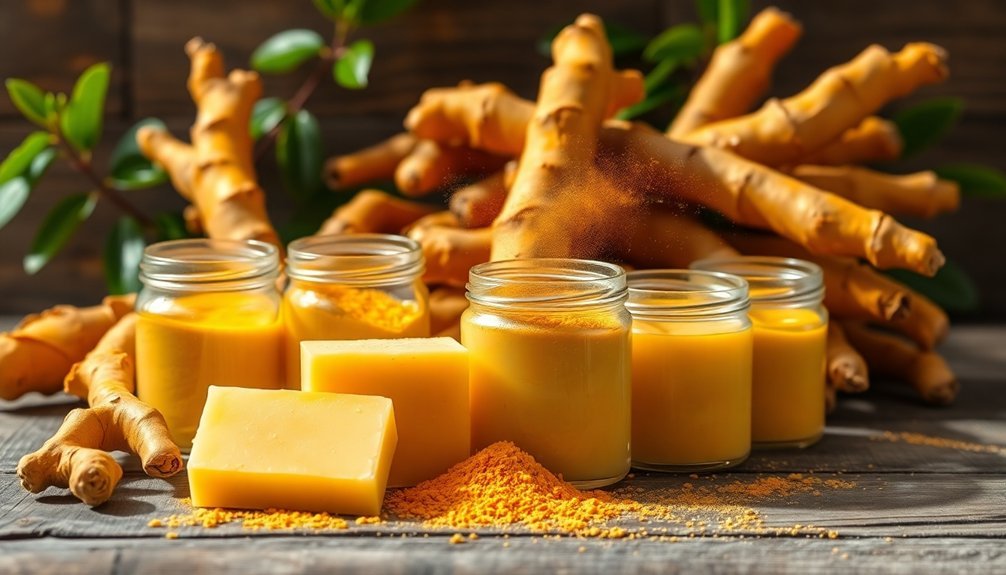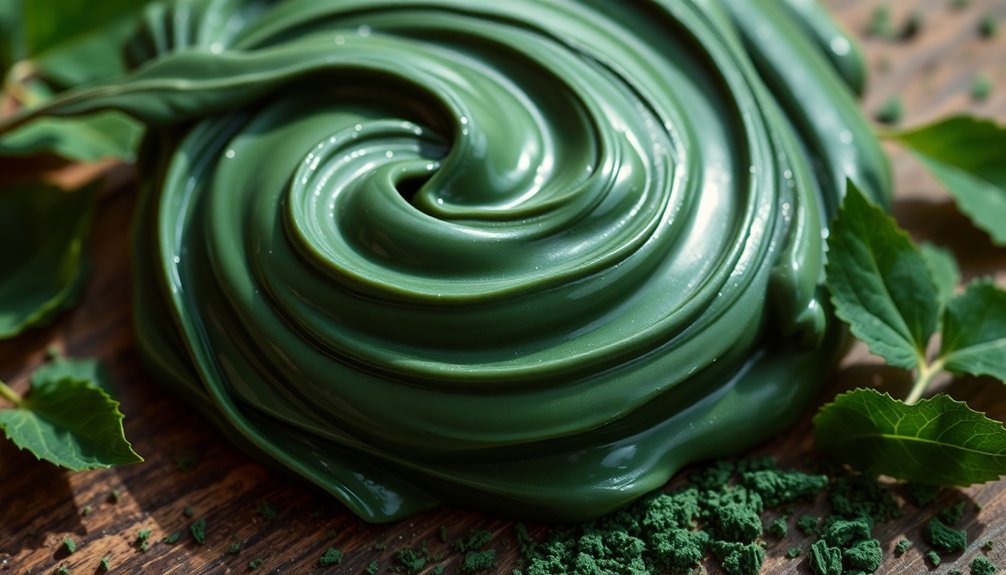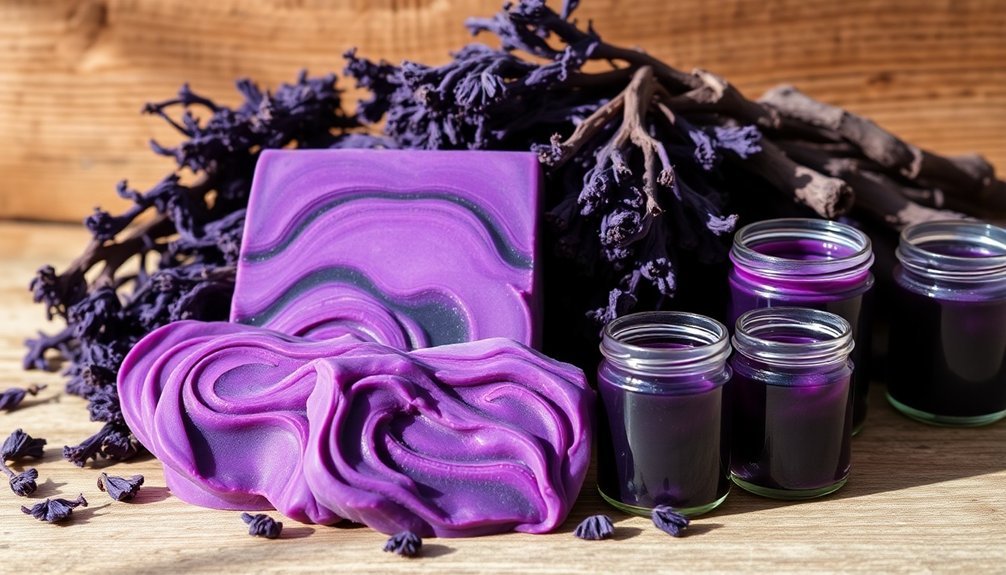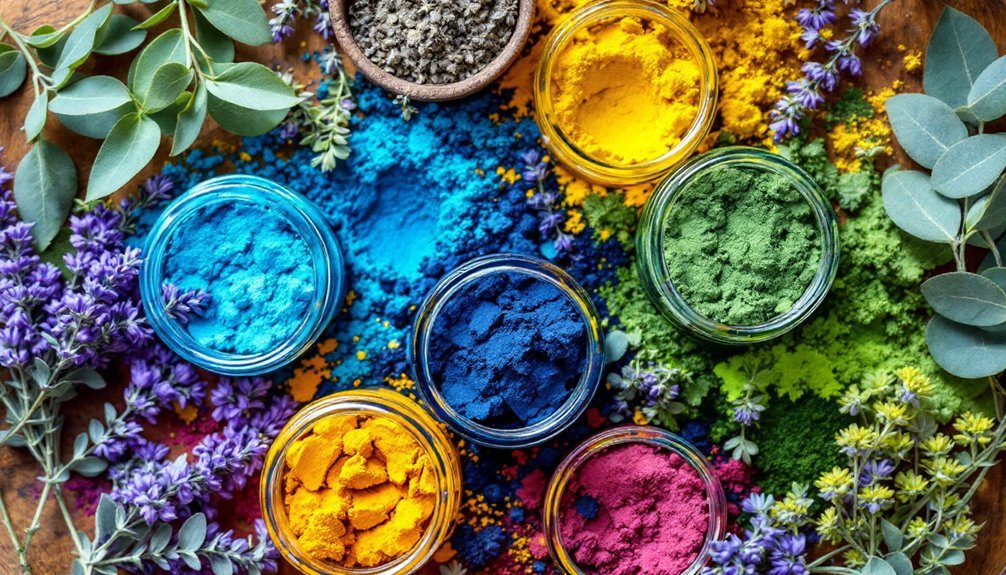Natural plant dyes can transform your homemade soaps with stunning colors while adding skin benefits. Try turmeric for yellow to orange hues, madder root for pinks and reds, indigo for blues, spirulina for greens, annatto seeds for warm oranges, alkanet root for purples, and cocoa powder for rich browns. You'll create unique, chemical-free products by infusing these botanicals in oils or adding directly to your soap mixture. Each natural colorant offers its own techniques and properties worth exploring.
Turmeric: The Golden Spice for Vibrant Yellow Soap

Turmeric stands as one of nature's most versatile color agents for soap making, offering shades ranging from delicate pale yellow to rich deep orange.
You'll find this golden spice brings more than just beautiful color to your creations—it delivers impressive skincare benefits too.
When incorporating turmeric into your soap, you can add it directly to your oil blend during cold process soap making, or mix it into a melt-and-pour base for a simpler approach.
The intensity of color depends entirely on how much powder you use: ¼ teaspoon for light yellow, ½ teaspoon for medium, and 1 teaspoon for a dark golden bar with more pronounced speckles.
Beyond color, you're adding turmeric's antioxidant and antimicrobial properties that even skin tone, reduce blemishes, and maintain hydration—making it perfect for both facial and body soaps.
Madder Root: Creating Stunning Reds and Pinks
Madder root, used as a textile dye since ancient civilizations, brings stunning reds and pinks to your soap creations.
You'll find that higher temperatures during oil infusion will extract more intense colors, while colder methods yield softer hues.
To incorporate this natural colorant effectively, try infusing the powdered root directly in your soap oils for several weeks before mixing with lye.
For the best results, begin with 5% infused oil for light pink shades, increasing to 15% for medium tones or 35% for deep burgundy hues.
Historical Dyeing Roots
For centuries, the humble madder root has transformed textiles and crafts with its remarkable red pigments, earning it a distinguished place in dyeing traditions across multiple continents.
The anthraquinone compounds, especially alizarin, have made madder a reliable source for vibrant crimson hues in historical dyeing practices.
When working with madder root in your soap making, you'll find:
- Different mordants dramatically alter the final color – alum produces clearer reds while iron creates deeper burgundies
- The pH level of your soap affects the shade intensity and stability
- Both oil and water infusions work effectively, giving you technique flexibility
- Environmental factors, including water hardness, influence your final color results
The traditional Turkish Red technique remained a closely guarded secret for centuries due to its unmatched clarity and vibrancy compared to other red dyes.
Temperature Affects Intensity
While exploring the world of natural soap colorants, you'll discover that temperature plays a crucial role in extracting madder root's full potential. Higher temperatures greatly accelerate color extraction when you add madder root to your lye solution, resulting in more vibrant reds and pinks.
If you're infusing madder root in oils, warmer temperatures will release colors faster than cold infusion methods, though the latter can work with extended soaking time.
Be mindful that direct sunlight and excessive heat during curing can cause your carefully crafted colors to fade.
For best results, strain your lye solution after adding madder root to avoid texture issues in your final soap.
Remember to store your finished madder-colored soaps away from sunlight to maintain those beautiful rosy hues you've worked to achieve.
When first poured, your soap batter will have a purple-brown appearance that gradually transforms to the expected strawberry red shade during the curing process.
Oil Infusion Methods
There are three primary oil infusion methods that will transform ordinary madder root into stunning colorants for your soap creations.
When preparing your infusion, choose light-colored oils like olive oil to better showcase the vibrant reds and pinks that madder root is known for.
- Cold infusion – Place dried madder root pieces in a glass jar with oil and store in a warm place for 2-4 weeks, shaking occasionally. For optimal results, use approximately 6 tablespoons of madder root per cup of oil.
- Hot infusion – Heat oil and madder root in a double boiler for 1-2 hours at low temperature for quicker results.
- Solar infusion – Let the sun gently warm your jar over several days (keep away from direct sunlight to protect oil quality).
- Crock pot method – Use low heat setting for 4-6 hours, allowing for a controlled warm infusion.
Indigo: Capturing Blues From Nature
The rich history of indigo stretches back centuries, making it one of nature's most treasured blue dyes for soap making. Derived primarily from *Indigofera tinctoria*, this natural colorant creates stunning blues ranging from pale sky to deep denim in your handcrafted soaps. The Natural Indigo Powder available in soap making supplies provides an authentic way to achieve these beautiful blue hues in your projects.
| Type | Color Result | Best Method |
|---|---|---|
| Blue Indigo | Deep Denim | Direct at Trace |
| Reduced Indigo | Intense Blue | Lye Solution |
| Infused Oil | Soft Pastel | Pre-infusion |
You'll achieve best results by first mixing your indigo powder with a lightweight oil to prevent clumping. Add it directly at trace for consistent distribution, or infuse in your oils for several weeks for lighter shades. For intensified color, try combining indigo with ultramarine blue or adding it to your lye water. Remember, light-colored base oils will showcase indigo's true blue hues better.
Spirulina: Deep Green Hues for Earthy Soaps

You'll find that processing spirulina powder by infusing it into your soap oils prevents any scratchy texture while enhancing color distribution throughout your batch.
This blue-green algae creates stunning verdant tones ranging from soft sage to deep forest green, depending on how much you incorporate.
Unlike some natural colorants, spirulina doesn't bleed or cause colored lather, making it perfect for creating visually striking, skin-nourishing soaps with detoxifying properties.
For optimal results, disperse 1 teaspoon of spirulina powder in 1 tablespoon of lightweight oil before adding to your soap mixture.
Processing Spirulina Powder
Three primary methods exist for incorporating spirulina powder into your soap creations: direct addition at trace, oil infusion, and pre-mixing with a small soap portion. Each technique offers different benefits for color distribution and texture control.
For best results when working with spirulina:
- Use ½ to 2 teaspoons per pound of soap for consistent coloring
- When infusing, combine 2 tablespoons spirulina with 1 cup of oil
- Strain infused oils through a fine mesh sieve to prevent grittiness
- Mix spirulina with a small portion of soap first to avoid lumps
Oil infusion is particularly effective as it extracts the vibrant green color while leaving behind the plant material that could create unwanted texture. Monitoring the heat temperature during infusion prevents overheating that could damage the spirulina's color properties.
You'll achieve smoother soap with even color distribution through this method.
Vibrant Green Applications
Spirulina's rich pigmentation creates some of the most striking green hues available in natural soap making.
You'll find this blue-green algae transforms your soap from white to vibrant green, with intensity varying based on usage rates—typically ½ to 2 teaspoons per pound of soap.
Unlike matcha which browns quickly or French green clay which yields tan colors, spirulina provides stable green coloration without bleeding or colored suds.
For best results, infuse it in your oils before soap making to prevent grittiness and guarantee consistent color distribution. This technique can be achieved by heating one teaspoon spirulina with two ounces of oil in the microwave for 30 seconds.
Spirulina excels in rainbow soap designs and earth-toned creations, pairing beautifully with essential oils like eucalyptus.
The higher temperatures of gel phase can enhance color vibrancy, giving your handmade soaps that distinctive eco-friendly, artisanal appeal that synthetic dyes simply can't match.
Annatto Seeds: Infusing Orange Warmth
Vibrant and versatile, annatto seeds offer soap makers a natural way to infuse their creations with warm orange and yellow hues.
These seeds from the achiote tree provide a food-safe coloring option that works beautifully in cold process soap making.
For best results with annatto seeds:
- Infuse in liquid oils like olive oil using either cold infusion (24+ hours) or hot infusion (1-2 hours)
- Control color intensity by adjusting the seed-to-oil ratio and infusion time
- Use no more than 20% annatto-infused oil in your recipe to prevent colored lather
- Store finished soaps away from direct sunlight to maintain their vibrant color
You can create various shades from sunny yellow to deep pumpkin orange by simply adjusting your infusion strength and the amount used in your recipe. The recommended starting point is approximately 4 teaspoons of seeds per 8 ounces of carrier oil for a well-balanced infusion.
Alkanet Root: Purple Magic in Cold Process Soap

Ancient herbalists treasured alkanet root for its medicinal properties, but soap makers prize it for its remarkable ability to create stunning purple hues. This natural dye contains alkannin, an oil-soluble pigment that transforms into rich purple shades in your soap's alkaline environment.
To harness alkanet's full potential, infuse it in a carrier oil like olive oil using about 5g of root per 100g of oil. Let it steep for several weeks until you achieve a ruby-red infusion. Using shredded alkanet root rather than powdered form will result in a smoother soap texture without grittiness.
Patience reveals alkanet's magic – a deep ruby infusion develops slowly, rewarding the mindful soapmaker with nature's vibrant gift.
When added to your soap batch, this red liquid magically shifts to purple as the soap saponifies.
For best results, avoid mixing alkanet with green or yellow ingredients that might turn your purple to muddy brown.
Consider testing small batches first, as factors like pH and essential oils can influence your final color.
Cocoa Powder: Rich Browns for Chocolate-Scented Bars
While purple hues from alkanet root can create mystical bars, cocoa powder offers a more grounded alternative with its warm, earthy tones.
Dutch processed varieties deliver deeper browns at lower quantities than natural cocoa powder, making them ideal for rich chocolate-inspired soaps. When compared to natural cocoa powder, Dutch processed options have neutralized acidity that enhances their coloring capabilities.
For best results with cocoa powder:
- Start with just ½ teaspoon per pound of oils—you can always add more to intensify color
- Premix with a small amount of your base oils or water before adding at trace
- Pair with vanilla or cinnamon fragrances for thematic consistency
- Consider sprinkling some on top for visual texture and artistic appeal
Though cocoa powder smells chocolatey during preparation, don't worry—this scent won't remain in your finished bars, allowing your chosen fragrance to shine through.
Frequently Asked Questions
Will Natural Dyes Fade Over Time in Soap?
Yes, natural dyes will fade over time in your soap. Light and heat accelerate this process. You'll see better longevity by storing soaps away from direct sunlight and using oil-infused colorants when possible.
How Can I Prevent Natural Colorants From Bleeding Between Soap Layers?
Use mineral pigments or micas instead of dyes, guarantee each layer forms a skin before pouring the next, keep temperatures below 130°F, and spritz with alcohol between layers to prevent bleeding.
Are Natural Soap Dyes Safe for Sensitive Skin?
Natural soap dyes are generally safer for sensitive skin than synthetic alternatives. You'll find they're less likely to cause irritation, but if you have specific plant allergies, you should still check ingredients carefully.
Can I Mix Different Plant Dyes to Create Custom Colors?
Yes, you can mix different plant dyes to create custom colors. Experiment with combinations like indigo and woad for deeper blues or spirulina and turmeric for greens. Remember that quantities matter for achieving your desired intensity.
Do Natural Dyes Affect Soap's Lather or Cleansing Properties?
Natural dyes won't greatly impact your soap's lather, as oils and fats are more influential. However, some plant dyes like marigold do offer antibacterial properties that can enhance your soap's cleansing benefits.
In Summary
You're now ready to transform your soaps with these seven natural plant dyes! Whether you're seeking vibrant yellows, rich reds, soothing blues, or earthy greens, nature provides everything you need. Don't be afraid to experiment with different infusion methods and concentrations to achieve your desired colors. As you craft your homemade soaps, you'll discover that natural dyes add both beauty and beneficial properties to your creations.





Leave a Reply